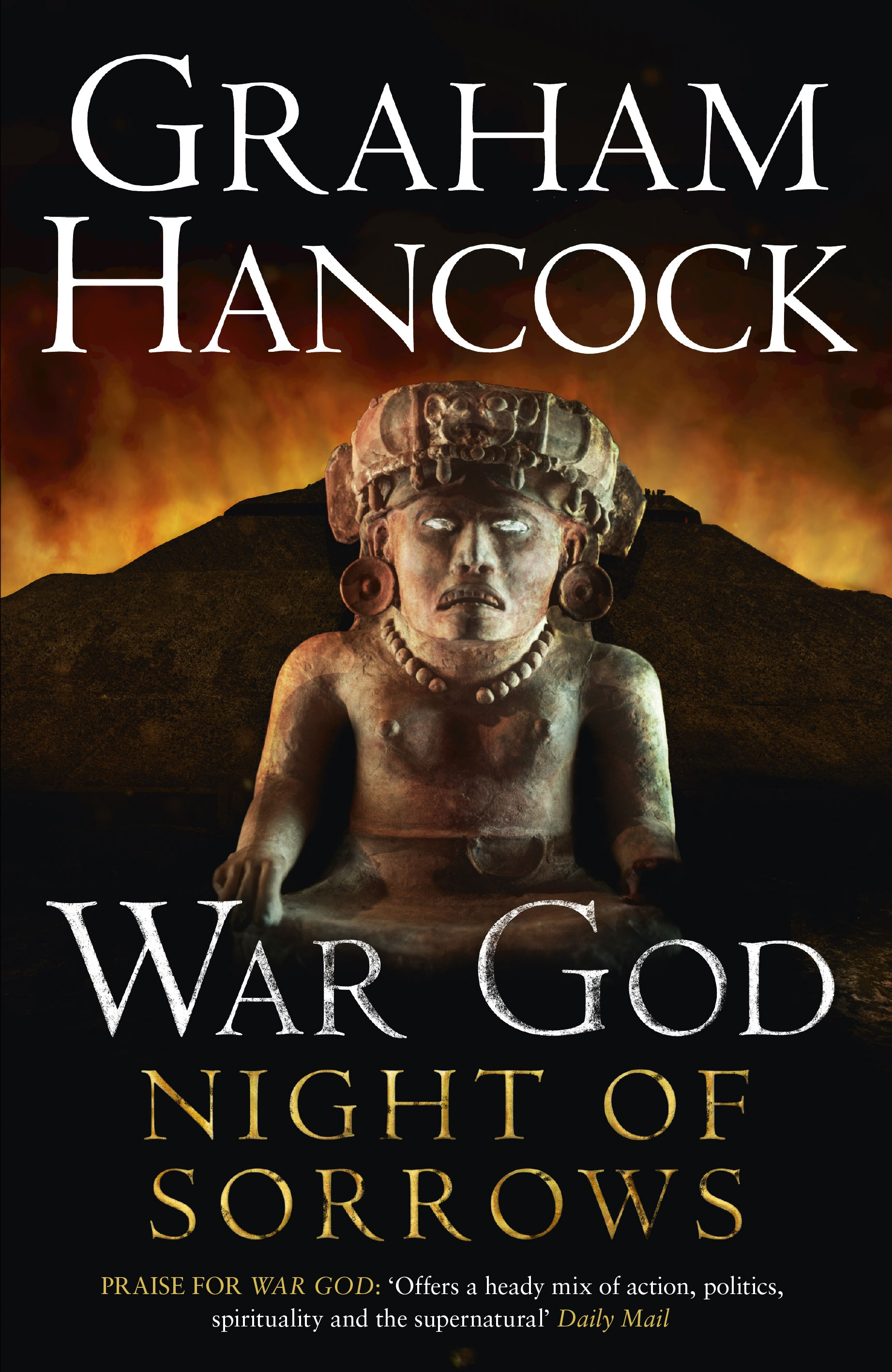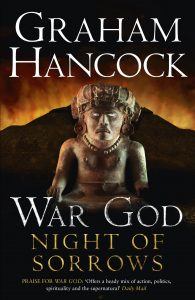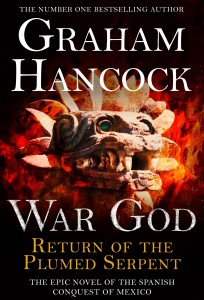Synchronicity!
I’m settling down to start work on the first chapter of Volume 4 of my War God series of novels about the Spanish conquest of Mexico when a report pops up in my newsfeed announcing that archaeologists have discovered the remains of the palace where the Mexica Emperor Moctezuma was killed – a key event in the story of the conquest.
I’m best known for my non-fiction books, but when I get time I challenge myself creatively by writing novels and I have now written three volumes of the War God series (further information, and a video trailer, here: http://grahamhancock.com/wargod/).
In celebration of this moment of synchronicity as I start Volume 4 – the final volume of the series – I’m including a short extract below of the scene from Volume 3 in which I describe the killing of Moctezuma.
THE BACKGROUND TO THE SCENE IS AS FOLLOWS:
It’s June 1520. Hernan Cortes and his small army of conquistadors are besieged in the sacred complex at the heart of the Tenochtitlan, capital city of the Mexica – the fierce warrior people known to history as the Aztecs. Prominent buildings in the complex include the palace of the Mexica Emperor, Moctezuma, and the palace of Moctezuma’s late father Axayacatl. Moctezuma himself has been the prisoner, hostage and puppet of Cortes for six months, ordering his people to make no resistance, but now they have rebelled against his commands, risen up against him, placed his brother on the throne and declared all-out war on the invaders. In a last desperate ploy, gambling that the deposed Emperor will still have influence, Cortes has Motezuma led under guard to the battlements of the palace where he addresses the besieging Mexica warriors, demanding that they cease the attack and withdraw at once. They respond with a shower of sling-shots and arrows and Moctezuma is hit several times.
According to the Spanish account of these events, Moctezuma was killed on the spot by the stones and arrows of the outraged Aztecs. According to the Aztec account Moctezuma received only minor injuries, which he survived, but soon afterwards was brutally murdered by the Spaniards along with other members of the Aztec nobility held prisoner in the palace.
I have chosen to go with the Aztec account which I dramatize in Chapter 22 of Volume 3 of the War God series – War God: Night of Sorrows. The point of view in the scene extracted below is that of one of the heroines of my story, the witch Tozi, who has no love for the Spaniards but is determined to kill Moctezuma for her own reasons, and who has the power to make herself invisible allowing her to move freely, unobserved by others, wherever she chooses.
EXTRACT:
When the white-skins took Moctezuma, grabbing him with their filthy hands, carrying him slung by the arms and legs like a sacrificial victim, Tozi followed…
[Their destination proved to be] the foetid room set aside as the jail for Cortes’ high-ranking Mexica prisoners. Cloaked in invisibility, Tozi had visited it two days earlier, had left quickly, and had not felt the need to return. She cared nothing for Cacama or Itzququhtzin or Atlixcatzin or any of the other arrogant bullies rotting in there.
The room itself was lit only by narrow skylights but now, as the Spaniards swung the heavy door wide, Tozi saw it was much more crowded than it had been before. She recognised two of Moctezuma’s wives, his ailing son and his three daughters amongst the newcomers revealed in the spill of light from the hallway. There were others there who she did not know. All but a handful sat, or slouched, or lay huddled on the floor. All were exceptionally dirty. Most had been beaten and it looked as if about half had been tortured. Tozi had not noticed the terrible injuries done to the soles of Cacama’s feet on her last visit, but she did now. The only explanation was that he must have been held over a fire.
Some of the prisoners groaned as the door was opened. In the bowels of the room another howled like a dog and a third laughed maniacally. There were cries of recognition from the children as Moctezuma was seen, his face bobbing, pale as a ghost, and a further chorus of shrieks and gasps as the Spaniards threw him down. It was only then, as the back of his head bounced off the shit-smeared floor, that Tozi understood what was intended here. An instant later, when the squad of soldiers drew their swords and hefted their hatchets and hammers, everyone else understood too.
There were close to thirty Mexica in that dreadful room, mostly men, but now also some women and children, all in very poor health. There were eight Spaniards – the four who’d carried Moctezuma, their mean-faced sergeant, and three more. They began the butchery at once, grim and silent except for the bestial grunts some of them made as they hacked their blades and smashed their bludgeons down on Mexica heads. Most of their victims were already on the floor, which made the task of slaughtering them so much easier, but even those few who were standing were too weak and terrified to fight and the Spaniards cut them down in an instant.
Soon the whole room was a shambles of blood and guts and amputated limbs and struck off heads. A few of the prisoners still showed signs of life, writhing or crying out, but a soldier with a spear and a cruel laugh finished them off one by one.
Moctezuma they kept until last, and it was the sergeant who killed him, thrusting a dagger five times into his chest, impaling the thin, graceful, fluttering hands he raised in a final, hopeless attempt to defend himself, and finding his heart…
The butchered bodies of the murdered Mexica nobles, Moctezuma’s amongst them, were removed from the prison room, carried down the stairs and heaped up in the palace courtyard like so much offal. Tozi followed, invisibly observing, curious as to what would happen next. Even amongst the Spaniards, she saw, there were those who seemed horrified by the killings, some crossing themselves, muttering under their breath, others looking away and giving the mound of corpses a wide berth…
END OF EXTRACT FROM VOLUME 3 OF WAR GOD.
http://grahamhancock.com/wargod/










Surprise cave discoveries may double the time people lived in the Americas
According to a paper published today in the journal Nature, the site, known as Chiquihuite Cave, may contain evidence of human occupation that places people in North America around 30,000 years ago—roughly twice as early as most current estimates for when the first humans arrived on the continent.
https://www.nationalgeographic.com/history/2020/07/surprise-chiquihuite-cave-discovery-mexico-double-peopling-americas/?utm_source=pocket-newtab
I wonder if you have noticed the very strong resemblance between carvings at Shinmao, in Shaanxi, China, dated to 2300 BC, and Mayan imagery.
It seems unlikely that archaeologists could survive publishing anything about it.
I refer specifically to this image. Look at the smaller images to the right, in particular.
https://www.nationalgeographic.com/history/2020/08/mysterious-carvings-evidence-human-sacrifice-uncovered-ancient-city-china/#/shimao-carving-face.jpg
Also compare the Kwakiutl (Pacific Northwest Washington/Vancouver) figure of Sisiutl:
https://duckduckgo.com/?t=ffab&q=sisiutl&iax=images&ia=images